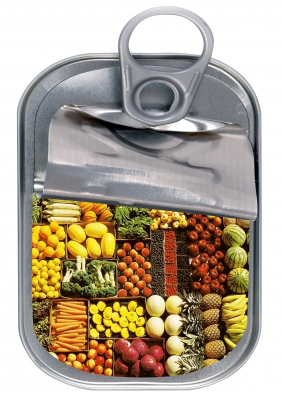From the Food Bank Kitchen: Why choose canned produce?

Image courtesy of xedos4 at FreeDigitalPhotos.net
When you think of canned goods what comes to mind? Soup? Beans? Tuna? For many, produce might not be the most obvious answer. But canned fruits and vegetables have many benefits and can be a great way to meet your dietary recommendations on a budget, while avoiding food waste.
31% of people in Massachusetts report eating fruit less than one time a day, and 20% report eating vegetables less than one time a day. The Dietary Guidelines for Americans recommend that most individuals should be eating at least 2 cups of fruit and 2½ cups or more of vegetables daily, to maintain good health. Fruits and vegetables are rich in vitamins and minerals that help make you healthy and keep you strong, as well as fiber which helps keep you fuller longer.
You have three main options when purchasing your produce at the supermarket: fresh, frozen, or canned. While fresh produce is highly regarded for its outstanding nutrition value, canned items have a number of advantages to people shopping on a tight budget. Not only do they reduce preparation and cooking time, but they are also easy to store and have a long shelf life. With canned items, you can create delicious meals in minutes. To help you prepare healthy meals when you have limited time, keep your pantry stocked with canned items such as beans, lentils, vegetables, tomato products, and broth.
Canned goods are an easy and affordable way to increase the variety of fruits and vegetables you eat all year. 15-20% of all fresh produce is thrown away each year, so canned goods are a great way to reduce waste. Canned produce counts towards your daily intake of fruits and vegetables. Reports show that frequent canned food users have higher intakes of both fruits and vegetables. In addition, as they are usually canned hours after harvest in air tight containers, they may have even more nutrients than out of season fresh produce.
When purchasing canned fruits and vegetables, there are a few nutrition concerns to keep in mind. Salt, or sodium, is something to try and minimize in your diet. The general adult population should consume 2,300 mg or less. While it is true that many processed foods are higher in salt, many canned vegetables offer low sodium or no salt added options which can be great alternatives. For instance, a typical ½ cup serving of regular green beans contains 380 mg of sodium, while a ½ cup serving of “No Salt Added” green beans may contain 10-40 mg.
Another way to reduce the amount of salt in canned produce is to drain and rinse it through a colander before use, which can reduce salt by nearly half. Sodium levels are often highest in products like soups, broths, and prepared foods like beef stew. Make sure you look at the serving size and compare it to what you normally eat; for instance, many soup cans are actually 2 servings.
In addition to salt, sugar is something else that should be reduced in our normal diet. When it comes to canned foods, this can be a concern. However, it can be easily resolved by choosing products canned in juice, light syrup, or water. Canned fruit in heavy or light syrup will always contain more sugar than canned fruit in water or juice. People with high blood sugar concerns may choose to rinse fruit that has been packaged in syrup, to reduce its sugar content.
Canned foods are a great choice to include in a balanced diet. As long as you pay attention to the nutrition facts labels to help you make the healthiest choice when shopping, delicious meals are just a can opener away.
Sources: cansgetyoucooking.com, mealtime.org, fruitsandveggiesmorematters.org